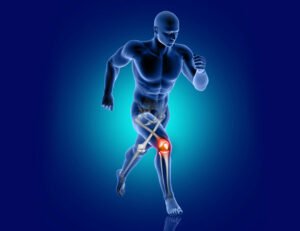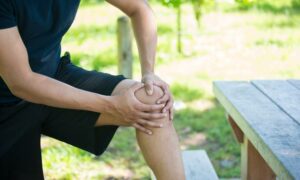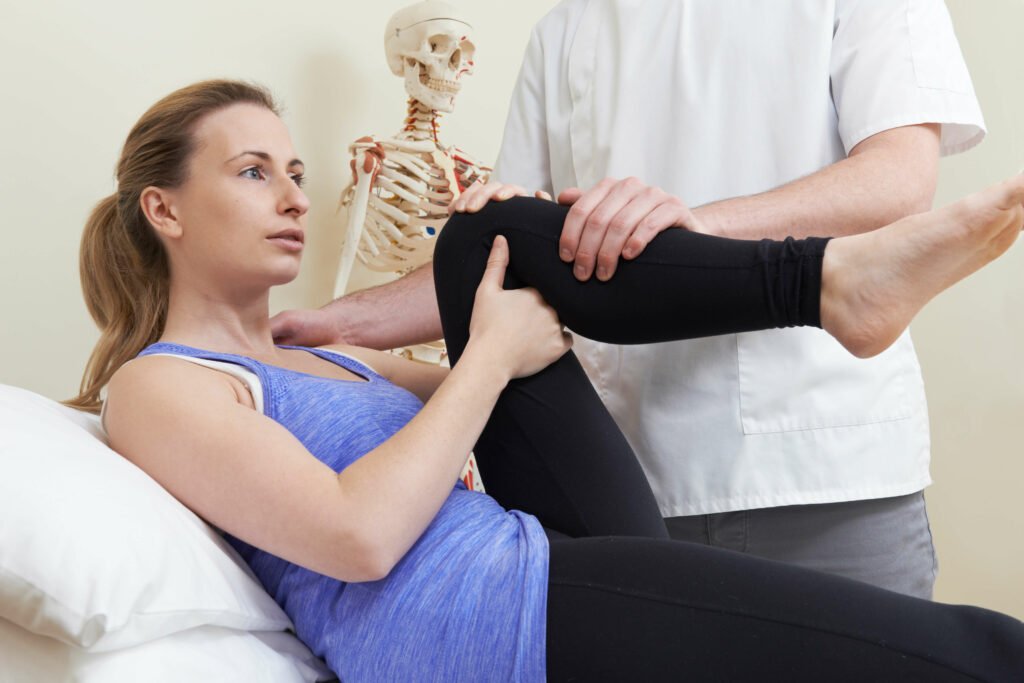Knee pain can be a relentless intruder in our lives, hindering our daily activities and diminishing the joy in movements we often take for granted. Whether it’s a result of an injury, overuse, or conditions like arthritis, knee pain can significantly impact our quality of life. However, the path to relief doesn’t always involve invasive procedures or heavy medication. Physical therapy emerges as a beacon of hope for those seeking a non-invasive, holistic approach to tackle knee pain and regain their mobility. This blog deals with the details of physical therapy for knee pain.
Contents
Understanding Knee Pain

Understanding knee pain requires a grasp of the complex structure of the knee joint and the various factors that can contribute to pain in this area. The knee joint is one of the largest and most complex joints in the body, involving bones, ligaments, tendons, muscles, and cartilage. Here’s a breakdown of the key components and potential causes of knee pain:
Anatomy of the Knee:
- Bones: The knee joint consists of three main bones: the femur (thigh bone), the tibia (shin bone), and the patella (kneecap).
- Ligaments: Ligaments are tough bands of tissue that connect bones to other bones and provide stability to the joint. The knee has four main ligaments: the anterior cruciate ligament (ACL), the posterior cruciate ligament (PCL), the medial collateral ligament (MCL), and the lateral collateral ligament (LCL).
- Tendons: Tendons are tough cords of tissue that connect muscles to bones. The quadriceps tendon and patellar tendon are important tendons around the knee.
- Cartilage: There are two types of cartilage in the knee. The articular cartilage covers the ends of the bones, allowing them to glide smoothly against each other. The meniscus is a C-shaped piece of cartilage that acts as a shock absorber between the femur and tibia.
Assessment and Diagnosis
Assessing and diagnosing knee pain involves a thorough evaluation of the patient’s medical history, a physical examination, and potentially various imaging and diagnostic tests. Here’s a step-by-step overview of the assessment and diagnosis process for knee pain:
Medical History:
- The healthcare provider will start by asking about your symptoms, including the location, duration, and nature of the pain.
- They will inquire about any previous injuries, surgeries, or medical conditions that could be contributing to the knee pain.
- Information about your daily activities, exercise routines, and occupation can provide insights into potential causes of the pain.
Physical Examination:
- The healthcare provider will examine the knee joint, looking for signs of swelling, redness, deformity, or any visible abnormalities.
- They will assess your range of motion, stability, and any pain during movement.
- Special tests might be performed to check for specific conditions, such as ligament or meniscus injuries.
Benefits of Physical Therapy for Knee Pain

Physical therapy can offer numerous benefits for individuals. This is for experiencing knee pain, regardless of whether the pain is due to an injury, a chronic condition, or other factors. A skilled physical therapist can create a tailored treatment plan to address the underlying causes of knee pain. Here are some of the key benefits of physical therapy for knee pain:
- Pain Relief: Physical therapists use various techniques, such as manual therapy, modalities (like heat or cold therapy), and therapeutic exercises. It is to help reduce pain and inflammation in the knee joint.
- Improved Mobility and Function: Physical therapy focuses on restoring and enhancing the range of motion and flexibility in the knee joint. This can help individuals regain their ability to walk, climb stairs, and perform daily activities without pain.
- Strengthening Muscles: Weak muscles around the knee can contribute to instability and pain. Physical therapists design exercises to target and strengthen the muscles that support the knee joint. It improves its stability and reduces the risk of further injury.
- Enhanced Joint Stability: Physical therapy can help individuals develop better proprioception (awareness of joint position) and balance, which are crucial for maintaining joint stability and preventing falls.
- Customized Exercise Programs: Physical therapists create personalized exercise regimens based on the individual’s specific needs and goals. These programs might include stretching, strengthening, aerobic exercises, and functional activities.
Customized Physical Therapy Plans
Customized physical therapy plans are designed to address an individual’s unique needs, goals, and specific conditions. These plans are developed by licensed physical therapists and are tailored to the patient’s medical history, current physical condition, and desired outcomes. Here’s an overview of how customized physical therapy plans are created:
- Initial Assessment: The process begins with an initial assessment by a physical therapist. This assessment includes a thorough review of the patient’s medical history, any existing injuries or medical conditions, and their current level of pain and mobility.
- Goal Setting: The physical therapist and the patient collaborate to set realistic and achievable goals. These goals might include reducing pain, improving range of motion, increasing strength, returning to specific activities, or preventing further injuries.
- Individualized Treatment Plan: Based on the assessment and goals, the physical therapist develops an individualized treatment plan. This plan outlines the specific interventions, exercises, techniques, and modalities that will be used to address the patient’s needs.
Techniques of Physical Therapy for Knee Pain
Physical therapy for knee pain involves a variety of techniques aimed at reducing pain, improving mobility, and enhancing the overall function of the knee joint. These techniques are tailored to the individual’s specific condition and needs. Here are some common techniques used in physical therapy for knee pain:
Therapeutic Exercises:
- Strengthening Exercises: Target specific muscle groups around the knee to improve stability and support. Examples include leg presses, squats, step-ups, and hamstring curls.
- Range of Motion Exercises: Gentle movements to improve flexibility and joint mobility.
- Isometric Exercises: Muscle contractions without joint movement, helping to build strength without stressing the joint.
- Proprioceptive Exercises: Activities that challenge balance and coordination to enhance joint stability.
Manual Therapy:
- Joint Mobilization: Skilled hands-on techniques to improve joint mobility and reduce stiffness.
- Soft Tissue Mobilization: Techniques like massage and myofascial release to alleviate muscle tension and improve blood flow.
- Stretching: Manual stretching techniques to improve muscle and soft tissue flexibility.
Modalities:
- Heat Therapy: Applying heat to the knee can help relax muscles, improve blood flow, and reduce stiffness.
- Cold Therapy: Cold packs or ice can help reduce inflammation and numb pain.
- Ultrasound: High-frequency sound waves are used to generate heat deep within the tissues, promoting healing and reducing pain.
Electrical Stimulation:
- Transcutaneous Electrical Nerve Stimulation (TENS): Electrical impulses are delivered through electrodes to reduce pain by interfering with pain signals.
- Neuromuscular Electrical Stimulation (NMES): Uses electrical impulses to stimulate muscle contractions, aiding muscle strengthening and reducing atrophy.
Balance and Proprioception Training: Exercises to improve balance and proprioception (awareness of joint position), helping prevent falls and enhance joint stability.
Functional Training: Activities that simulate real-life movements and tasks, helping individuals regain the ability to perform everyday activities without pain.
Bracing and Taping: Customized knee braces or taping techniques can provide external support to the knee joint, aiding stability and reducing pain.
Gait Training: Analyzing and correcting walking patterns to ensure proper alignment and reduce stress on the knee joint.
Education: Educating patients about their condition, body mechanics, and strategies for pain management and injury prevention.
Home Exercise Programs: Providing patients with exercises they can perform at home to complement in-clinic sessions and maintain progress.
Cryotherapy: The use of cold therapy to reduce inflammation and pain. This can include ice packs, ice baths, or cryotherapy machines.
Avoiding Surgical Interventions

Avoiding surgical interventions for knee pain is often a desirable goal, especially when there are effective non-surgical treatments available. Here are some strategies and approaches that can help individuals avoid or delay the need for surgical interventions:
- Physical Therapy and Rehabilitation: Engage in a comprehensive physical therapy program designed to strengthen the muscles around the knee, improve joint stability, and enhance overall function. Physical therapy can be highly effective in managing many types of knee pain and injuries.
- Pain Management Techniques: Explore various pain management techniques, such as over-the-counter or prescription medications, physical modalities like heat and cold therapy, and techniques like acupuncture or chiropractic care.
- Weight Management: Maintaining a healthy weight can reduce the stress on the knee joint. Excess body weight places added strain on the knees, contributing to pain and the development of conditions like osteoarthritis.
Recovery and Long-Term Maintenance
Recovery from knee pain and maintaining long-term joint health involves a combination of strategies to manage symptoms, prevent recurrence, and promote overall well-being. Whether you’ve undergone treatment, or surgery, or are managing knee pain through non-surgical means, these tips can help you achieve lasting results:
- Follow Medical Recommendations: Adhere to the recommendations provided by your healthcare professionals, whether it’s regarding medication, physical therapy exercises, lifestyle changes, or any other aspect of your treatment plan.
- Gradual Return to Activities: If you’ve been advised to avoid certain activities during recovery, gradually reintroduce them under the guidance of your healthcare provider or physical therapist. This is to prevent overexertion and re-injury.
- Stay Active: Engage in regular, low-impact exercise to maintain joint health and overall fitness. Activities like swimming, walking, cycling, and yoga can be beneficial for the knees.
Conclusion
Knee pain doesn’t have to be an everlasting burden. Physical therapy offers a holistic, patient-centric approach to relieve knee pain and restore your quality of life. By addressing the root causes, building strength, and promoting proper movement, physical therapy empowers you to regain control over your body and live life to the fullest.
Physical Therapy helps patients recover from pain. If you’re experiencing Back, Shoulder, Knee, Neck, Elbow, Hip, or Arthritis pain, a physical therapist at PhysioMantra can help: Book an online physical therapy session.



